|
Coalite, a School, and a Plaque
Thomas invented the smokeless fuel 'Coalite' in 1904,
it was one of his most important inventions. Large quantities were
sold, and the Low Temperature Carbonisation Company, which produced
'Coalite', was run by Thomas's son, Charles. On 14th January, 1936
Thomas was posthumously awarded a gold medal by the Smoke Abatement
Society for his invention. The medal was presented to Charles, on
his father's behalf, by Dr. H.A. des Voeux, president of the
society, at a luncheon in London.
|
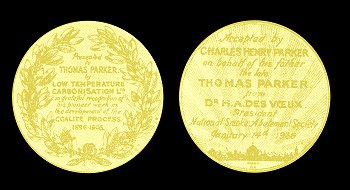
Thomas's posthumous medal.
|
The medal has now been lost, it was stolen from
Thomas's daughter, Jessie, many years ago.
Although Thomas never made a penny from his invention,
because it was ahead of its time, the Low Temperature Carbonisation
Company was extremely successful after his death.
In 1906 production started at Wednesfield,
and in 1908 patent rights were granted in a number of other
countries. Thomas Parker had found a way around the problem of
casting the retorts which had been experienced by other
foundries.
In 1936 the company built a large factory at Bolsover,
Derbyshire, which employed 1,000 men in the production of 'Coalite'.
The plant occupied 17 acres, had two miles of railway sidings and
288 retorts. The company signed a contract for 1,000,000 tons of
coal for the new plant. Each ton of coal produced four gallons of
petrol, 18 gallons of oil and 14cwt. of smokeless fuel. 12 squadrons
of the Royal Air Force exclusively used petrol that was produced by
the company and the Royal Navy purchased large quantities of oil.
The company also produced a wide range of speciality chemicals and
recycling solutions for waste.
Unfortunately in 2004 the company was in receivership
and the production of Coalite ceased on June 10th. Its virtues were
listed in a long article in The Times newspaper on 4th May, 1907,
from which the following extracts were taken:
| The career of Mr. Thomas Parker, J.P., M.
Inst C.E., M. Inst. M.E., M. Inst. E.E, of
Wolverhampton, the inventor of Coalite, is one
of those of commercial and scientific activity
which are rarely recorded until the subject of
them has passed from out of our midst. It would
be no excessive compliment to speak of Mr.
Parker as an English Edison. Nearly a generation
ago he invented a steam pump which took a medal
at the Inventions Exhibition. About 1878 he was
the first to design and build a dynamo for the
deposition of metal from solutions to take the
place of the huge cells then in vogue. In
partnership with Mr. Bedford Elwell, the firm of
Elwell-Parker, Limited became famous throughout
the world, and one of its most notable
performances was to design and construct the
electrical plant for the first electrically
driven tram system of any considerable size in
this country. In 1888 the firm was absorbed into
the Electric Construction Corporation, Limited,
and many very noteworthy enterprises were
successfully carried out by this Company under
Mr. Parker's direct management, such, for
instance, as the design and construction of the
Liverpool Overhead Railway. In the field of
chemistry Mr. Parker's achievements are also
remarkable. He it was who solved the problem of
the successful pyro-electric extraction of
phosphorus, and his patented processes are at
present used in all the great phosphorus works.
In 1900, Mr. Parker was called in by the
Directors of the Metropolitan Railway to take
charge of the contemplated electrification of
the line, and from the results of his
experiments the Directors caused specifications
to be drawn up by Mr. Parker, and ultimately not
only the Metropolitan but also the District
Railway was electrified on almost identically
the same principle as that employed in his
construction of the Liverpool Overhead Railway.
Something over 50 specifications stand to his
credit in the Patent Office.
Mr. Parker has also written and spoken much
upon the subject of the reform of Units of
Measurement, and is one or the most active
members of the British Weights and Measures
Association, formed to oppose the introduction
of the Metre and its derivatives into this
country. He has pointed out, with all the weight
of his long engineering experience behind him,
that the inch forms in every way a more
advantageous and practical unit than the metre.
Quite apart from the hygienic aspect of the
smoke evil, Mr. Parker was deeply impressed by
the enormous economic waste of which coal-smoke
is merely the outward and visible sign. Before
ever the Royal Commission on our coal supplies
reported that, of the 150 millions of tons of
coal annually used in this country, 60 millions
are burnt to waste, Mr. Parker had recognized
the facts and had realised the import of this
gigantic loss and the consequences that are
bound to ensue if the national resources
continue to be squandered with this reckless and
senseless prodigality. As early as 1881 a Gold
Medal was awarded to Mr. Parker at the Smoke
Abatement Exhibition for his invention of the "Kyrle"
grate for the consumption of anthracite and
other fuels. He soon realised, however, that
what was needed was the production of a
smokeless fuel, and not merely the provision of
mechanical contrivances for economical
consumption.
The fuel must be absolutely smokeless, and
must be of such a nature that it cannot emit
smoke. Unlike coke, the fuel must be capable of
being readily lighted. It must be adapted for
satisfactory consumption in any existing grate,
stove, or kitchen range, and must provide the
cheerful ore insisted upon by popular choice,
and must emit neither unpleasant nor unhealthy
fumes. It must be in other respects as
convenient and relatively as cheap as the
present alternative fuels.
In the midst of his busy life, Mr. Parker
tried many extensive experiments with a view to
eliminating the smoky gases from bituminous
coal. In the end he discovered a process of
treating coal of any size or quality in such a
manner as to extract completely the whole of the
smoke-producing elements, and at the same time
to increase the calorific value of the resulting
product.
Coalite is much more bulky, by reason of its
porosity, than an equal weight of coal, and
since it lasts much longer, radiates more heat,
and burns more steadily than a coal fire, and is
converted entirely into carbon dioxide (no loss
occurring in the shape of smoke or of carbon
monoxide), and since also, even at its present
price, it is cheaper than coal, it may
reasonably be expected before long to prove
itself so very economical that its use will
become universal, not perhaps so much from any
urgent desire to assist in the promotion of
smokeless London, as simply on the ground of the
actual money - saving effected through its use.
Coalite has triumphantly passed the ordeal of
independent and searching tests made under the
direction of the Coal Smoke Abatement Society,
and has amply demonstrated its ability to meet
the points already referred to as being
essential in a perfect fuel.
Tests were conducted in rooms forming part of
the large block of buildings situated at the
corner of Great George Street, Westminster, now
being constructed under the superintendence of
Sir Henry Tanner, Chief Architect to H.M.
Government. The trials, which extended over 13
days, were performed under conditions and
regulations precisely similar to those issued
for the grate tests held under the auspices of
the same Society in July, 1905 (the Lancet of
19th May, 1906).
The tests of the sample submitted for
examination have demonstrated that Coalite is
easily lighted, and that it remains most of the
day glowing and cheerful, with a yellow flame
varying in size, while it emits no smoke. It
further requires little or no attention, as it
has no tendency to cake. No carbon monoxide was
detected in the flue gases, indicating that
practically perfect combustion had been secured.
As with with good coal, Coalite maintains a more
uniform fire and keeps the temperature of the
room more steady. It does not die down into an
inert looking mass, and deposits no soot.
The founders of the Coalite industry have no
doubts about its successful future, and they are
laying their plans upon a scale commensurate
with the expected demand for a fuel which
combines within itself all the qualities which
have so long been vainly desiderated. A long
frontage to the Thames, over a mile in length,
together with some hundreds of acres of
hinterland, have been secured, and works are
being put down of a size sufficient to deal with
from three to four millions of tons of coal
annually. The plant used in the preparation of
Coalite is entirely different from that used at
present in the gas and coke manufacture. The
stills are automatic and continuous in their
action, and the coal fed in at the top emerges
as Coalite at the bottom. As the apparatus
undergoes no destructive high temperatures, the
wear and tear is small, and the perpetual
renewals common in gas making practice are
rendered unnecessary.
Last, but not least, Coalite will bring to
fruition the hopes of those who have written,
preached, and striven for a cleaner life in a
purer atmosphere. At last it will be possible
for Londoners to breathe a wholesome air,
uncontaminated with the smoke fumes and fogs
they have so long endured. Every one will
rejoice if the lives of our cathedrals and other
national buildings may be lengthened, and if the
beauty of our priceless treasures of art may be
preserved. The flowers and trees in our parks
and gardens will at last be able to grow with
natural vigour; and, most important of all, we
may rejoice in the thought that our children
will not be handicapped by those abnormal and
unhealthy conditions which the black smoke
nuisance has too long imposed. They at least
will see and enjoy the fulfilment of the long -
cherished dream of A SMOKELESS LONDON. |
|
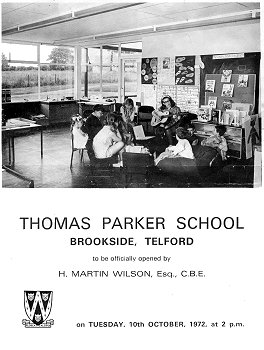 |
On 10th October, 1972 a new school opened at
Telford. It was called the Thomas Parker school in honour of
Thomas. When opened, the school catered for 40 children with
special needs.
Members of the Parker family attended the opening ceremony
and a large framed photograph of Thomas Parker, complete
with a list of his achievements, was presented to the
school.
The school still exists today and is now called the Bridge
School. |
| At long last Thomas is getting some well-deserved
recognition in Wolverhampton. On 26th February, 2007 a
new exhibition opened at Bantock House, featuring a
number of important historical figures from the City's
past. One of them is Thomas Parker. In May 2007 a new
artwork, in several parts, has been erected in Riches
Street, celebrating Thomas and his works. |
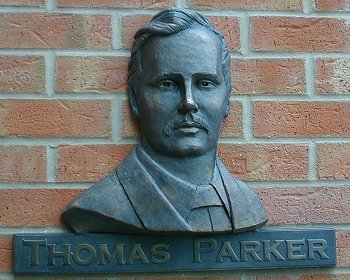
Part of the new plaque. Courtesy
of John McKenna. |
| The reliefs were designed and cast in bronze
by John McKenna, who has several other sculptures in
the area. His works are designed and manufactured in
his studio at Turnberry, Ayrshire, Scotland. |
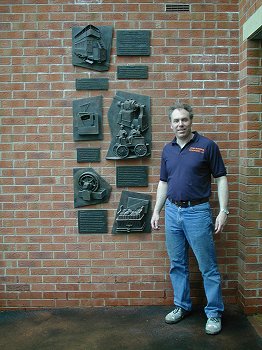
John McKenna and the
reliefs that depict many of Thomas's
achievements. Courtesy of John McKenna. |
John was involved in the plaques at St.
John's Retail Park in Wolverhampton that
celebrate car makers Sunbeam and Star, and the
Boulton Paul Defiant relief sculpture at
Pendeford. John's many local works include the
'Child At Play' steel railings features at
Wednesbury, the Green Man Sculpture relief for
the Green Man Passage in Dudley, way markers for
the Midland Metro tram line along the length of
a cycle path at West Bromwich, the 'Lucas Lion'
stainless steel relief sculpture on the former
Lucas Car parts production site at Newtown in
Aston, Birmingham, the 'Genie of Industry'
stainless steel artwork at Longbridge,
Birmingham, the Colossus of Brownhills, the 12
metre high stainless steel statue of a coal
miner that stands at Brownhills to celebrate the
areas' former coal mining industry, the
'Needles' Canopy at Butlers Passage, Walsall,
and the Palfrey Horse, which stands in Palfrey
Park, Walsall. Visit John's
website: www.a4a.co.uk |
| The top relief shows an early tram, similar
to the ones used on the Blackpool Tramway and
the South Staffordshire Tramway. The text reads
as follows: 1843 - 1915
Engineer & Scientist
Lived close to this site and worked on
many of his inventions here in Wolverhampton,
some of which are described on this plaque.
1881
Responsible for the first electric tramway
in the world at Portrush, Northern Ireland,
powered by the first hydro electric generator.
1882
Founded the first company in the Midlands
to manufacture electrical equipment such as
dynamos, motors, switchboards and transformers. |
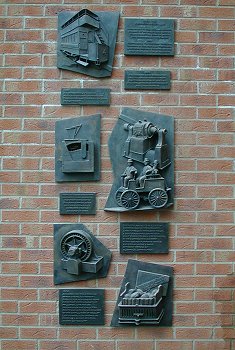
Another view of the
reliefs. Courtesy of John McKenna. |
| The middle relief on the left shows the
Wednesfield furnace and the text reads as
follows: 1887
Wednesfield Furnace. Invented the method
of producing phosphorus and chlorate of soda by
electricity.
The middle relief on the right shows a Parker
dynamo and one of his early cars. The text is as
follows:
Thomas Parker designed and built cars.
Possibly the first motorist in Wolverhampton as
he had an electrically operated vehicle as early
as 1884.
The bottom but one relief on the left shows a
Parker alternator and the text reads as follows:
Designed and built multi-phase alternators
with stationary armatures and revolving fields,
a very successful design for many years. He used
the principal in alternating current furnaces
for purifying metals and establishing a more
efficient method of electrical distribution.
The bottom relief on the right shows a Kyrle
grate and the text is as follows:
Awarded two gold medals by the smoke
abatement society for perhaps his most important
work against air pollution. One for his
invention of the Kyrle fire grate and one for
his invention of distillation of coal by low
temperature method to produce a smokeless fuel -
"Coalite".
|
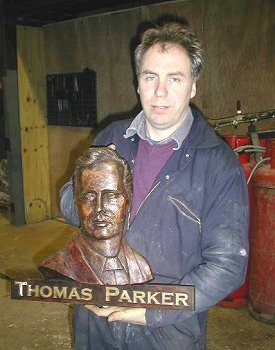
John McKenna holding
"Tom".
Courtesy of John McKenna. |
|
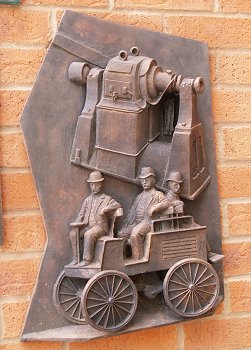
An Elwell-Parker dynamo
and a Parker car from about 1895. |
|
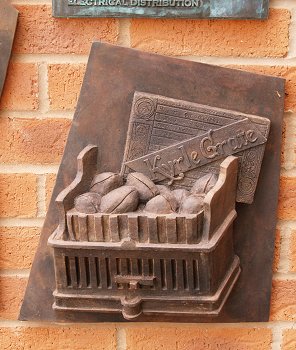
The Kyrle grate produced
by the Coalbrookdale Company from about 1880. |
|
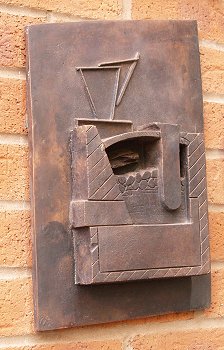
A Wednesfield furnace. |
|
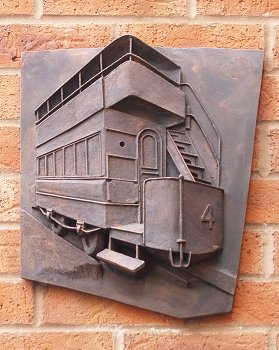
An early Parker tram. |
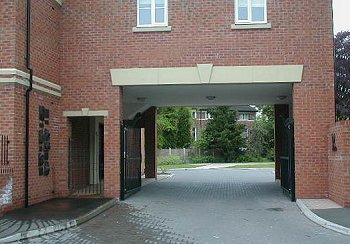
A final view of the plaques. Courtesy
of John McKenna.

|
|

|
|

|
Return to
the Funeral |
|
Return to the beginning |
|
Proceed to
Commemoration |
|